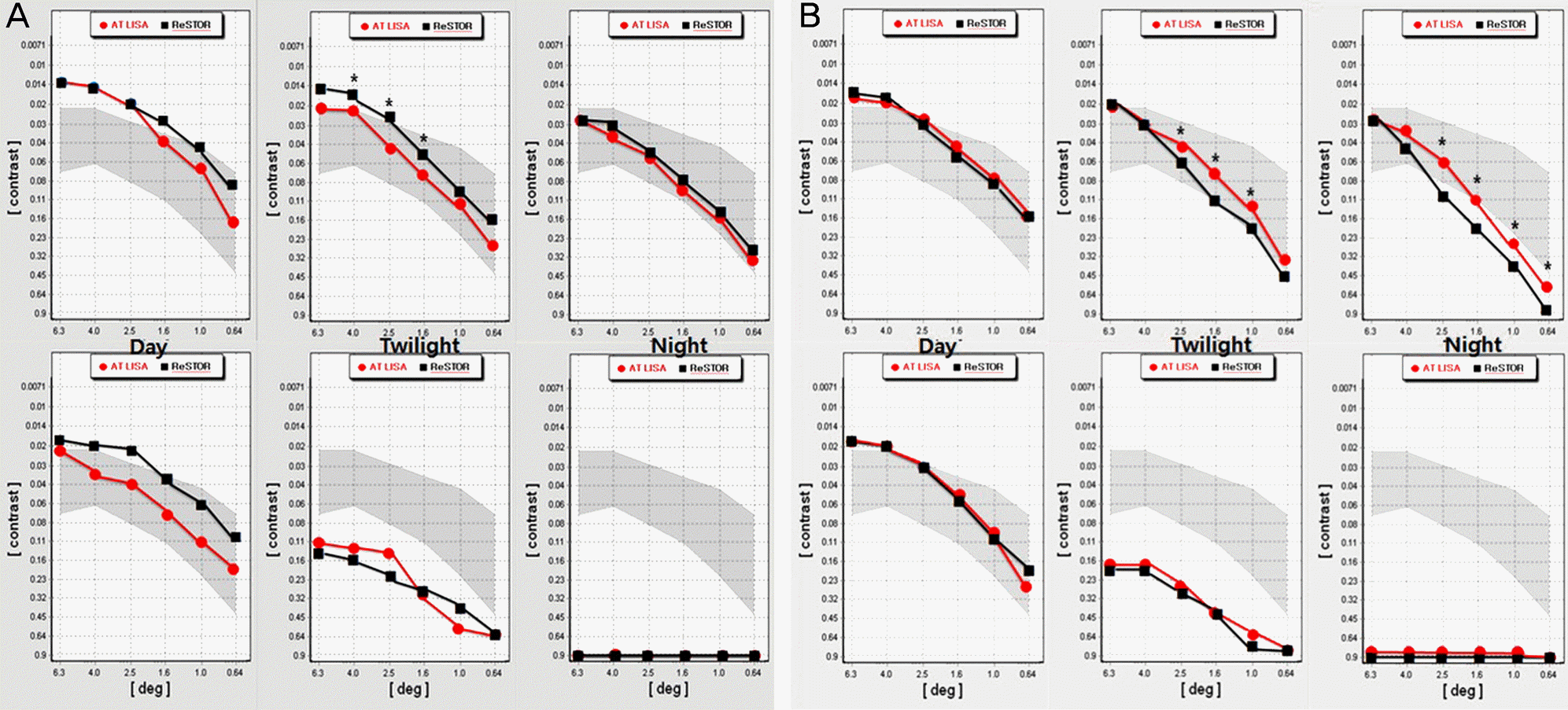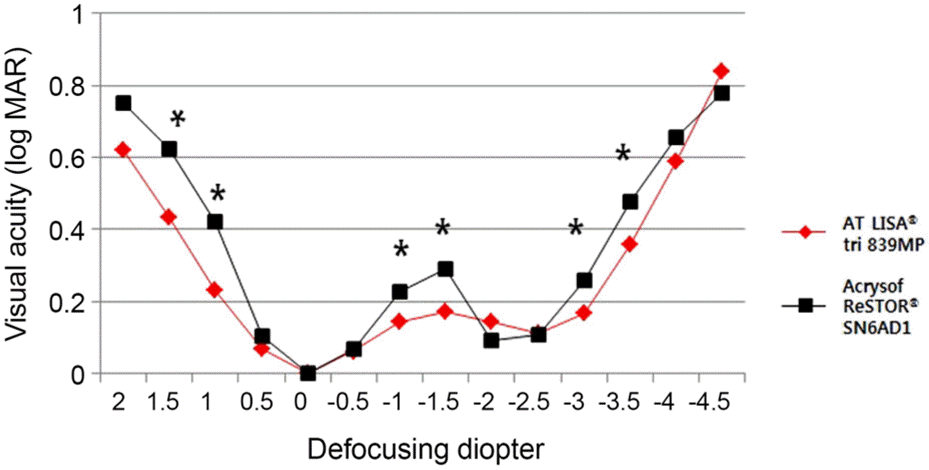Abstract
Purpose
To evaluate and compare visual outcomes and optical quality after implantation of a bifocal (Acrysof ReSTOR® SN6AD1) or trifocal (AT LISA® tri 839MP) diffractive intraocular lens (IOL).
Methods
Fifty-one eyes of 43 patients undergoing cataract surgery were enrolled and assigned to one of two groups: the trifocal group, comprising 24 eyes implanted with the trifocal diffractive IOL (AT LISA® tri 839MP), and the bifocal group, comprising 27 eyes implanted with the bifocal diffractive IOL (Acrysof ReSTOR® SN6AD1). Visual acuity (distant, intermediate, and near vision) and refractive postoperative outcomes were evaluated at one and three months postoperatively. Measurements of optical quality (using OQAS II®), contrast sensitivity (using CGT-2000®), automated visual field examination, and evaluation of defocus curve were performed three months postoperatively.
Results
No statistically significant differences between the two groups were found in three-month postoperative distant and near (40 cm) visual acuities and optical quality. However, intermediate (63 cm, 80 cm, and 100 cm) visual acuities were significantly better in the trifocal group. Distant contrast sensitivity (5 m) under mesopic conditions was significantly better with the bifocal lens, whereas near contrast sensitivity (30 cm) under mesopic and scotopic conditions was significantly better with trifocal lens. There was no statistical difference between the groups under photopic conditions. In the defocus curve, the visual acuity was significantly better at intermediate distance in the trifocal group.
Conclusions
Trifocal diffractive IOLs provide significantly better intermediate vision than bifocal IOLs, with equivalent postoperative levels of distant and near vision and ocular optical quality. Further, they provide better near contrast sensitivity under scotopic condition compared to diffractive bifocal IOLs.
Go to : 
References
1. Davison JA, Simpson MJ. History and development of the apodized diffractive intraocular lens. J Cataract Refract Surg. 2006; 32:849–58.

2. Alfonso JF, Fernández-Vega L, Baamonde MB, Montés-Micó R. Prospective visual evaluation of apodized diffractive intraocular lenses. J Cataract Refract Surg. 2007; 33:1235–43.

3. de Vries NE, Webers CA, Montés-Micó R, et al. Long-term follow-up of a multifocal apodized diffractive intraocular lens after cataract surgery. J Cataract Refract Surg. 2008; 34:1476–82.

4. Park YL, Hwang GY, Joo CK. Comparative study of clinical outcomes between 2 types of multifocal aspheric intraocular lenses. J Korean Ophthalmol Soc. 2013; 54:1199–207.

5. Blaylock JF, Si Z, Vickers C. Visual and refractive status at different focal distances after implantation of the ReSTOR multifocal intraocular lens. J Cataract Refract Surg. 2006; 32:1464–73.

6. Alfonso JF, Fernández-Vega L, Puchades C, Montés-Micó R. Intermediate visual function with different multifocal intraocular lens models. J Cataract Refract Surg. 2010; 36:733–9.

7. Voskresenskaya A, Pozdeyeva N, Pashtaev N, et al. Initial results of trifocal diffractive IOL implantation. Graefes Arch Clin Exp Ophthalmol. 2010; 248:1299–306.

8. Gatinel D, Pagnoulle C, Houbrechts Y, Gobin L. Design and qualification of a diffractive trifocal optical profile for intraocular lenses. J Cataract Refract Surg. 2011; 37:2060–7.

9. Cochener B, Vryghem J, Rozot P, et al. Visual and refractive outcomes after implantation of a fully diffractive trifocal lens. Clin Ophthalmol. 2012; 6:1421–7.

10. Sheppard AL, Shah S, Bhatt U, et al. Visual outcomes and subjective experience after bilateral implantation of a new diffractive trifocal intraocular lens. J Cataract Refract Surg. 2013; 39:343–9.

11. Alfonso JF, Puchades C, Fernández-Vega L, et al. Contrast sensitivity comparison between AcrySof ReSTOR and Acri. LISA aspheric intraocular lenses. J Refract Surg. 2010; 26:471–7.
12. Alfonso JF, Fernández-Vega L, Blázquez JI, Montés-Micó R. Visual function comparison of 2 aspheric multifocal intraocular lenses. J Cataract Refract Surg. 2012; 38:242–8.

13. Kim SM, Kim CH, Chung ES, Chung TY. Visual outcome and patient satisfaction after implantation of multifocal IOLs: three-month follow-up results. J Korean Ophthalmol Soc. 2012; 53:230–7.

14. Kim JH, Kim EJ, Kim YI, et al. Comparison of clinical outcomes between diffractive and refractive multifocal intraocular lens with same near added. J Korean Ophthalmol Soc. 2015; 56:875–84.

15. Kretz FT, Gerl M, Gerl R, et al. Clinical evaluation of a new pupil independent diffractive multifocal intraocular lens with a +2. 75 D near addition: a European multicentre study. Br J Ophthalmol. 2015; May. pii. bjophthalmol-2015-306811. [Epub ahead of print].
16. Marques EF, Ferreira TB. Comparison of visual outcomes of 2 diffractive trifocal intraocular lenses. J Cataract Refract Surg. 2015; 41:354–63.

17. Mojzis P, Kukuckova L, Majerova K, et al. Comparative analysis of the visual performance after cataract surgery with implantation of a bifocal or trifocal diffractive IOL. J Refract Surg. 2014; 30:666–72.

18. Cabot F, Saad A, McAlinden C, et al. Objective assessment of crystalline lens opacity level by measuring ocular light scattering with a double-pass system. Am J Ophthalmol. 2013; 155:629–35. 635.e1-2.

19. Lee K, Ahn JM, Kim EK, Kim TI. Comparison of optical quality parameters and ocular aberrations after wavefront-guided laser in-situ keratomileusis versus wavefront-guided laser epithelial keratomileusis for myopia. Graefes Arch Clin Exp Ophthalmol. 2013; 251:2163–9.

20. Saad A, Saab M, Gatinel D. Repeatability of measurements with a double-pass system. J Cataract Refract Surg. 2010; 36:28–33.

21. Aychoua N, Junoy Montolio FG, Jansonius NM. Influence of multifocal intraocular lenses on standard automated perimetry test results. JAMA Ophthalmol. 2013; 131:481–5.

22. Farid M, Chak G, Garg S, Steinert RF. Reduction in mean deviation values in automated perimetry in eyes with multifocal compared to monofocal intraocular lens implants. Am J Ophthalmol. 2014; 158:227–31.e1.

23. Lee JM, Seo KY, Kim EK. Comparison of optical aberrations and contrast sensitivity between monofocal and multifocal intraocular lens. J Korean Ophthalmol Soc. 2002; 43:1882–6.
24. Yoon JU, Chung JL, Hong JP, et al. Comparison of wavefront analysis and visual function between monofocal and multifocal aspheric intraocular lenses. J Korean Ophthalmol Soc. 2009; 50:195–201.

25. Kamiya K, Hayashi K, Shimizu K, et al. Multifocal intraocular lens explantation: a case series of 50 eyes. Am J Ophthalmol. 2014; 158:215–20.e1.
Go to : 
 | Figure 1.AT LISA® tri 839MP (left, adapted from Sheppard et al10), Acrysof ReSTOR® SN6AD1 (right, adapted from Davison and Simpson1). |
 | Figure 2.Contrast sensitivity test by CGT-2000®. (A) Contrast sensitivity at 5 m, (B) contrast sensitivity at 30 cm. Superior column tested when glare off, inferior column tested when glare on. deg = degree. *p < 0.05. |
 | Figure 3.Visual acuity at various defocus levels. The values are a mean of log MAR visual acuity. *p < 0.05. |
Table 1.
Patient demographics
|
Intraocular lens type |
p-value* | ||
|---|---|---|---|
| AT LISA® tri 839MP | Acrysof ReSTOR® SN6AD1 | ||
| Number of eyes (patients) | 24 (20) | 27 (23) | |
| OD:OS | 14:10 | 16:11 | |
| Sex (male:female) | 16:4 | 16:7 | 0.455 |
| Age (years) | 49.5 ± 6.7 | 52.4 ± 9.3 | 0.697 |
| S.E. (D) | 0.39 ± 1.09 | 0.32 ± 1.97 | 0.298 |
| UCDVA (log MAR) | 0.58 ± 0.79 | 0.38 ± 0.77 | 0.916 |
| Axial length (mm) | 24.03 ± 1.11 | 23.80 ± 0.78 | 0.372 |
| Corneal power (D) | 43.50 ± 1.48 | 43.73 ± 1.36 | 0.551 |
| Anterior chamber depth (mm) | 3.47 ± 0.41 | 3.34 ± 0.36 | 0.252 |
| Intraocular lens power (D) | 19.41 ± 2.72 | 20.03 ± 2.41 | 0.140 |
Table 2.
Visual acuity and spherical equivalent at postoperative 1 month and 3 months
|
1 month |
3 months |
|||||
|---|---|---|---|---|---|---|
| AT LISA® tri 839MP | Acrysof ReSTOR® SN6AD1 | p-value* | AT LISA® tri 839MP | Acrysof ReSTOR® SN6AD1 | p-value* | |
| S.E. (D) | −0.29 ± 0.35 | −0.19 ± 0.27 | 0.247 | −0.29 ± 0.36 | −0.13 ± 0.26 | 0.053 |
| BCDVA (log MAR) | 0.00 ± 0.00 | 0.00 ± 0.14 | 0.339 | 0.00 ± 0.00 | 0.00 ± 0.00 | − |
| UCDVA (log MAR) | 0.02 ± 0.07 | 0.02 ± 0.09 | 0.987 | 0.01 ± 0.07 | 0.02 ± 0.08 | 0.615 |
| UNVA (log MAR) | 0.10 ± 0.11 | 0.09 ± 0.13 | 0.339 | 0.09 ± 0.07 | 0.07 ± 0.10 | 0.446 |
| UIVA63 (log MAR) | 0.19 ± 0.12 | 0.24 ± 0.13 | 0.125 | 0.17 ± 0.11 | 0.24 ± 0.12 | 0.027* |
| UIVA80 (log MAR) | 0.07 ± 0.13 | 0.28 ± 0.09 | <0.001* | 0.06 ± 0.13 | 0.29 ± 0.11 | <0.001* |
| UIVA100 (log MAR) | 0.11 ± 0.09 | 0.29 ± 0.21 | <0.001* | 0.11 ± 0.13 | 0.29 ± 0.10 | <0.001* |
S.E. = spherical equivalent; D = diopter; BCDVA = best corrected distance visual acuity; log MAR = logarithm of the minimum angle of resolution; UCDVA = uncorrected distance visual acuity; UNVA = uncorrected near visual acuity at 40 cm distance; UIVA63 = uncorrected intermediate visual acuity at 63 cm distance; UIVA80 = uncorrected intermediate visual acuity at 80 cm distance; UIVA100 = uncorrected intermediate visual acuity at 100 cm distance.
Table 3.
Optical quality parameters measured by optical quality analysis system II® (OQAS II®) at postoperative 3 months
|
Intraocular lens type |
p-value* | ||
|---|---|---|---|
| AT LISA® tri 839MP | Acrysof ReSTOR® SN6AD1 | ||
| OSI | 1.28 ± 0.65 | 1.16 ± 0.40 | 0.425 |
| MTF cut-off value (cpd) | 42.52 ± 10.74 | 40.71 ± 8.75 | 0.504 |
| Strehl ratio | 0.37 ± 0.54 | 0.26 ± 0.10 | 0.325 |
| VA100 | 1.42 ± 0.36 | 1.36 ± 0.29 | 0.513 |
| VA20 | 1.10 ± 0.35 | 1.03 ± 0.34 | 0.512 |
| VA9 | 0.70 ± 0.27 | 0.68 ± 0.30 | 0.776 |
Table 4.
Visual field parameters measured by Humphrey field analyzer®: SITA-Fast at postoperative 3 months
|
Intraocular lens type |
p-value* | ||
|---|---|---|---|
| AT LISA® tri 839MP | Acrysof ReSTOR® SN6AD1 | ||
| MD | −1.95 ± 1.10 | −1.72 ± 1.08 | 0.257 |
| PSD | 1.46 ± 0.23 | 1.54 ± 0.32 | 0.366 |
| Fovea threshold | 34.60 ± 2.01 | 33.76 ± 2.59 | 0.240 |




 PDF
PDF ePub
ePub Citation
Citation Print
Print


 XML Download
XML Download